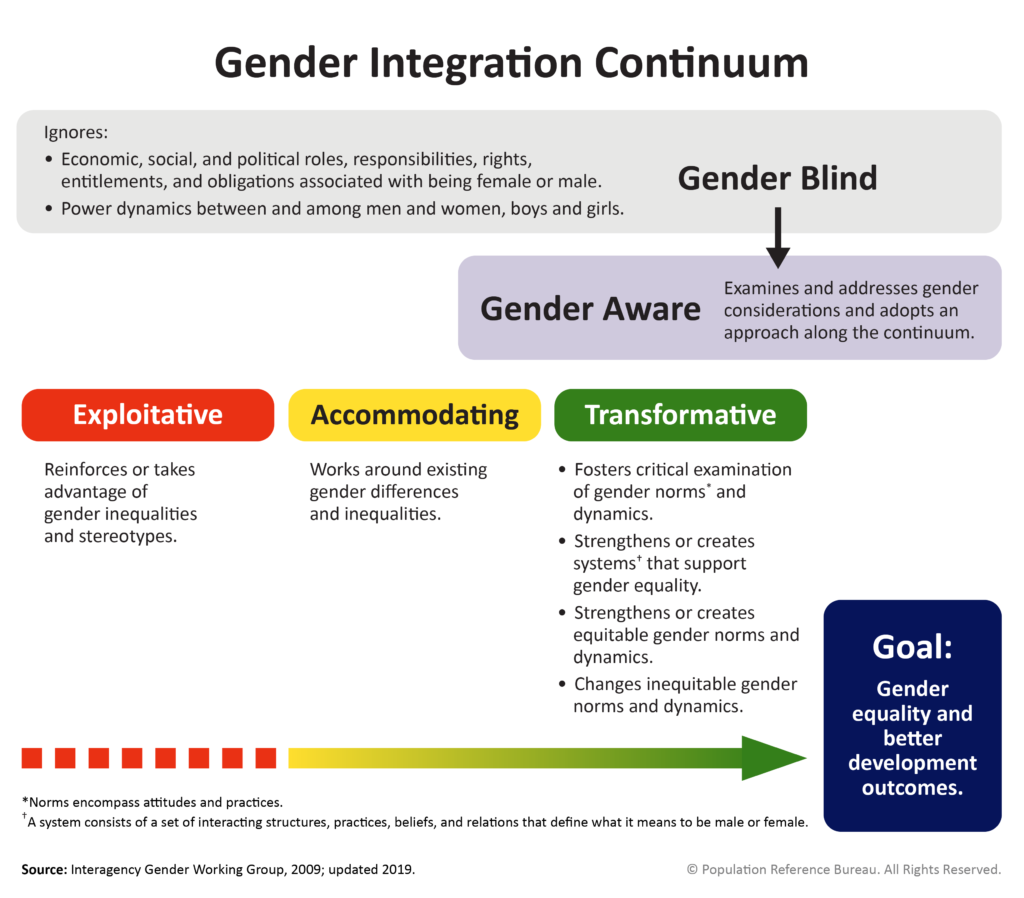The Gender 101 facilitation guide is a tested agenda that has now been used in dozens of Missions worldwide. Its compact, one-day design takes the audience from basic principals around sex and gender in the morning to more sophisticated gender analysis application in the afternoon. The concepts introduced in Gender 101 are the foundation of the training menu, and IGWG views this core session as a prerequisite to other training around technical topics such as GBV or CME. Sessions such as Defining Gender Terms and the Gender Continuum serve as the basis for moving forward to any conversation around gender analysis or transformative gender interventions. It is essential that participants have a shared understanding of vocabulary and comprehension of how to use the continuum before moving ahead with any technical depth.
It is strongly encouraged that the Gender 101 workshop take an entire day—especially for audiences who are new to gender. The most beneficial outputs stem from dialog; it is important not to rush participants through the sessions, but to allow them to discuss opinions and share ideas about how to apply these concepts to current and future programming.
Agenda: Gender 101
| Welcome/Introductions/Agenda | 60 minutes |
| “Vote With Your Feet” | 45 minutes |
| Break | 15 minutes |
| Defining Gender Related Terms | 45 minutes |
| IGWG Gender Integration Continuum | 90 minutes |
| Lunch | 1 hour |
| Gender in USAID’s Automated Directives Systems (ADS) | 45 minutes |
| Break | 15 minutes |
| Introduction to Gender Analysis and Integration | 120 minutes |
| Close/Evaluation | 15 minutes |
However, in cases where this workshop must be kept to a half-day session, the following elements need to be covered to ensure that the audience is introduced to the core components of Gender 101. Please see the half-day sample agenda below. Note that in the half day session, participants are simply introduced to gender issues and terms. Participants only acquire skills in gender analysis and integration when they are exposed to the full day session.
Agenda: Half-Day Gender 101 “Essentials”
| Welcome/Introductions/Agenda* | 30 minutes |
| “Vote With Your Feet” | 45 minutes |
| Defining Gender Related Terms | 45 minutes |
| Break | 15 minutes |
| IGWG Gender Integration Continuum** | 75 minutes |
| Gender in USAID’s Automated Directives Systems (ADS) | 45 minutes |
* For the half-day session it is important to cut the welcome and introductions to 30 minutes. In order to achieve this, the facilitator will need to skip the pairs exercise and simply go around the room and ask participants to briefly introduce themselves. Asking each individual to answer 3 questions is a good format. Have each participant say their name, their organization and/or position, and ask them a question that directly relates to the agenda. Options could be: what are you hoping to learn here today? What experience do you have in gender programming? What are your thoughts around gender integration? What is your experience with the ADS system?
** For the half-day session, the continuum section needs to be cut down by 15 minutes in order to finish on time. You can do this in a variety of ways: have each triad only place 1 case study on the continuum, have each triad place the same 3 case studies so the large group only needs to process three case studies, follow the guide as it is, but only discuss half of the case studies placed on the continuum before moving forward.
The Gender 101 design can be used in its original “generic” format or paired with one or more technical areas, depending on the audience. In particular, a facilitator can tailor the definitions they discuss, as well as the examples they use in “Vote with Your Feet,” the gender continuum, and the gender analysis/integration case study exercises to incorporate a specific technical focus on safe motherhood, GBV, CME, and/or HIV and sexuality. By using the menu of options and carefully selecting the right discussion questions and case studies, the IGWG menu allows each facilitator to tailor their Gender 101 workshop to the specific needs of his/her audience.
Example: A facilitator needs to give a 1-day Gender 101 workshop for 20 HIV specialists. The facilitator would download the Gender 101 1-day guide from the IGWG website and read the design thoroughly. In order to apply the workshop to the HIV technical audience, the facilitator goes to the HIV + Sexuality tab to find multiple options of processing questions and case studies specifically designed for those working in HIV and AIDS. By integrating these process questions and case studies into the generic Gender 101 design, the facilitator is able to tailor his/her design for the technical audience.


